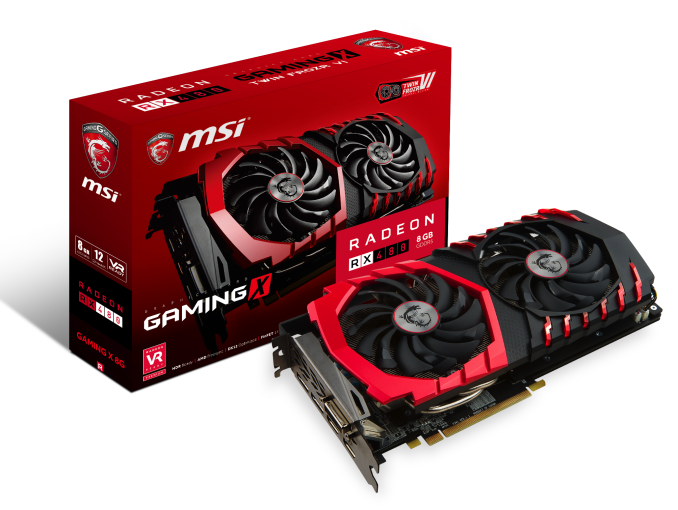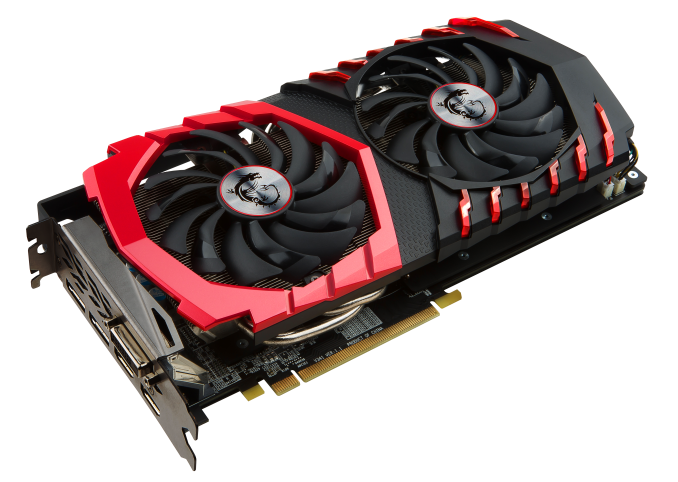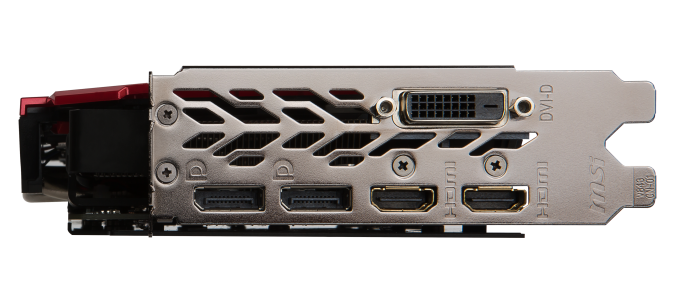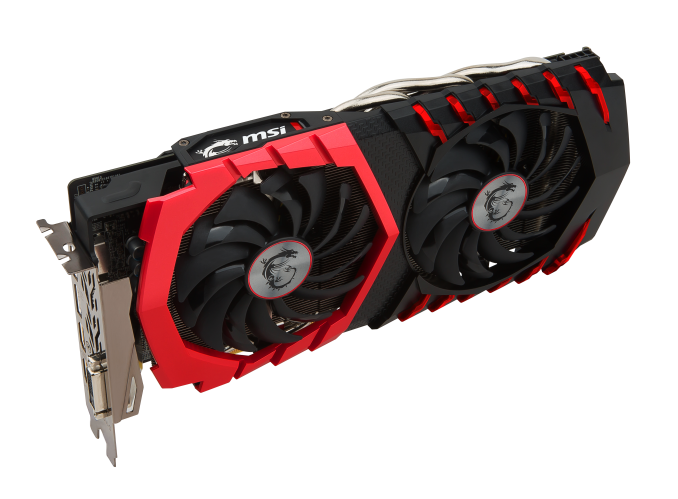MSI Shows New Radeon RX 480 Gaming Cards, with an 8-pin
by Daniel Williams on July 26, 2016 10:30 AM EST
Today MSI is announcing the latest entry in the Gaming X GPU line with the Radeon RX 480 Gaming X 8G/4G cards as well as non-X variants. The main difference between the non-X and X cards is in the core and memory frequencies, with the X card having the higher performance. In return, there will be a small price difference between the two variants.
| MSI Radeon RX 480 Gaming Specification Comparison | |||||||
| GAMING X 8G | GAMING X 4G | GAMING 8G | GAMING 4G | ||||
| Core Clock |
Silent | 1266 MHz | |||||
| Gaming | 1303 MHz | 1279 MHz | |||||
| OC Mode | 1316 MHz | 1292 MHz | |||||
| Memory Clock (Reg/OC) | 8.0/8.1 Gbps GDDR5 | 8.0 Gbps GDDR5 | |||||
| VRAM | 8 GB | 4 GB | 8 GB | 4 GB | |||
| Launch Date | TBD Mid August 2016 | ||||||
| Launch Price | Unknown ??? | ||||||
Starting with appearance, all four models shown today feature an angular, aggressive, red and black design for the cooler, which glows through the red highlights. On the side of the card is an MSI logo lit by customizable RGB lighting which is adjusted through the MSI Gaming software bundled with the card. Around back there is a full cover back plate on the Gaming X cards, and moving back around to the cooler we have two large fans over a full-length cooler and PCB. Running through the heatsink are three heat pipes at 8mm thick each. These heat pipes are squared off at the bottom and mated to a nickel-plated copper baseplate, aiming to increase contact with the GPU core and hence increase heat transfer. This cooler is toned down from that used on the highest end cards, but should still make for a very capable cooling solution.
Moving from form over to function, MSI’s RX 480 Gaming X cards are built from what MSI calls “Military Class 4” components, which is marketing speak for their choosing quality components to assemble this card. For power, the cards have a single 8-pin connector, and for the output we have two HDMI, two DisplayPort, and one DVI-D connection. This appears to be a very popular arrangement this generation, allowing one HDMI port for a monitor and another for a VR headset. MSI also use their TORX Fan 2.0 design which they say will generate 22% more air pressure, and like other Gaming and Gaming X cards the fans will shut off at temperatures below 60C. If true these fans coupled with the Twin Frozr VI heatsink could do an admirable job of quietly handling any heat an RX 480 can muster. For performance numbers on the Gaming X, we have a moderate clock speed gain over the reference card in OC mode, while the memory is bumped up to 8.1 Gbps in OC mode.
With no word on pricing, both 8GB and 4GB versions of the MSI Radeon RX 480 Gaming X are expected to be in stores worldwide around the middle of August 2016.



















34 Comments
View All Comments
xthetenth - Wednesday, July 27, 2016 - link
A new card with a warranty has some significant advantages, it's why used cards get priced lower than new ones of the same model.prisonerX - Tuesday, July 26, 2016 - link
With GameWorks shenanigans, a 980 with have the performance of Intel HD Graphics within a few months.medi03 - Tuesday, July 26, 2016 - link
Given pricing and availability of 1060, they sure can.FATCamaro - Tuesday, July 26, 2016 - link
OC mode is a joke at 5% OC. What's the point even... GloFo has bungled AMD's chances for a great card.medi03 - Tuesday, July 26, 2016 - link
To be honest, we don't know if it is GloFo or Samsung 14nm process vs TSMC 16nm in general.Although what I've got from toms where they compared apple's chips from both factories and figured Samsung was actually better (although, there were some donws too, it did consume less power).
The main reason AIBs will be faster is that ref 480... throttles. So gains from 5% OC will be more like 10%-ish.
hojnikb - Tuesday, July 26, 2016 - link
Exactly, It could just aswell be the architecture not being designed to run at high frequencies.Same story in the past with athlon xp vs p4
The_Assimilator - Tuesday, July 26, 2016 - link
There's nothing wrong with Samsung's 14nm process. There's plenty wrong with how GloFo has botched it.extide - Tuesday, July 26, 2016 - link
Oh yeah, like what?andrewaggb - Tuesday, July 26, 2016 - link
Too bad apple doesn't use glofo as well and we could compare tmsc to samsung to goflo.So far wasn't the consensus that tmsc is the better process?
BurntMyBacon - Wednesday, July 27, 2016 - link
Depends on who you ask. Toms says Sammy is marginally better. Just about everywhere else says TSMC to one degree or another. I'd guess TSMC is better on average, but perhaps by less the normal binning variation of the chips (which is to say, insignificant). How this translates into larger chips with compounding effects on clock and power distribution and unpublished defect rates remains to be seen.